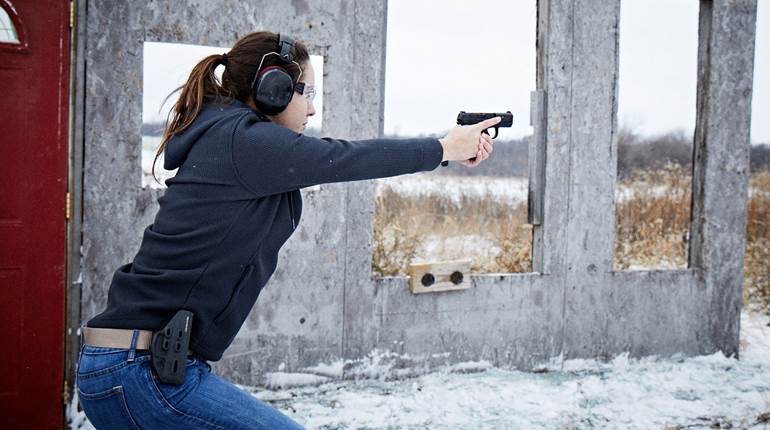
8/28/2012
A few years ago, I had the opportunity to spend a day with firearms expert Walt Rauch. During down times at the range, he regaled the participants with nearly unimaginable real-life stories of his adventures. He also told stories about gunwriting and gunwriters, including one about a group of gunwriters being asked their opinion on the best gun for self-defense. Almost every one answered the 1911 in .45 ACP in a strong-side holster, but when asked what they were carrying at that very moment, all but one said a five-shot .38 Spl. in a pocket holster.
Carrying a gun in the pocket dates back to the early days of firearms development. Back in the 1800s, it wasn’t en vogue to carry a gun openly in large cities, but some citizens still wanted to protect themselves. There are also many stories of famous gunslingers carrying derringers in coat pockets to back up the hoglegs on their hips, and it’s even said that Col. Rex Applegate carried a revolver in his hip pocket when protecting President Franklin D. Roosevelt.
In those days, the pocket was the holster. However, just as firearm technology changed, so did holsters. Today, pocket guns are an easy and convenient way to ensure that you always have a handgun for protection, and many gunmakers produce small, lightweight handguns that can be easily carried in a pocket holster.
While there are special shirts, jackets, vests and pants designed for carrying a gun in a pocket—some even fit full-size handguns—the best known, and most popular, way to carry a small pistol or revolver is in the front pants pocket. A gun in this location provides easy access with a fairly quick draw, but the largest benefit to a pocket gun is you can grip the gun without anyone ever realizing that you are ready and able to defend against a violent attack. You’re just a man or a woman with a hand in a pocket.
Drawing from the Pocket
While drawing from strong-side hip holster is the fastest way to quickly get a handgun into action, pulling from the pocket is faster than many other ways of carrying. It does, however, require some thought and practice. As stated earlier, you can easily begin the draw by having a hand on the gun, but since situations can happen suddenly, you should also train with your hand outside the pocket.
First, maneuver your hand into what martial artists call the spear (fingers rigidly straight out) as you enter your pocket. As your hand enters the pocket, the middle, ring and pinky (if grip is large enough) fingers wrap around the grip with the trigger finger along the frame of the gun and the thumb on top of the frame. Having the thumb on top both covers the hammer, if it has one, preventing it from snagging as the gun exits the pocket, and provides for an easier draw. The concept is simple; the thinner you can make your hand, the easier the gun will come out. If you wrap the thumb around the grip, it is like trying to pull your fist out of your pocket. As the gun leaves the pocket, the thumb should wrap into your shooting grip. From here, go to your shooting stance, or simply rotate and fire if there is little time, like with a charging assailant.
Choosing a Pocket Holster
There are many brands of pocket holsters from which to choose, ranging from inexpensive all the way up to high-end custom jobs. One benefit of pocket holsters is that it doesn’t take a lot of money to get a good one. A variety of holster manufacturers, such as DeSantis, Galco, Tuff Products and Uncle Mike’s, produce well thought out pocket holsters for less than $30. Some are very basic, while others have designs that also break up the profile of the gun. Whatever holster you choose should allow the gun to come out easily while the holster remains in the pocket. This can be done through a hook that catches on the pocket or via a sticky material that holds to the lining of the pocket.
You should also consider a holster that breaks the profile of the gun in your pocket, which is often done with a flange that makes it look like you have a wallet in your pocket, rather than a gun. Of course, it all depends on where you carry the gun. Today’s cargo and tactical pants provide multiple locations for a gun, along with large, roomy pockets from which a gun can be easily hidden and quickly drawn. You can even carry one in a shirt pocket if it’s small enough.
Writer’s Way
While I don’t carry a pocket gun on a regular basis, I do carry a J-frame Smith & Wesson in a Tuff Products Pocket-Roo or a Ruger LCP in a DeSantis Pocket Shot. In fact, I sometimes carry both, with the Smith in my left front pocket and the LCP in my right hip pocket. This allows either hand easy access to a gun. I like a pocket gun for quick trips to the store when I don’t feel like strapping on an IWB holster. I also like to carry in the large pocket of cargo shorts as it provides a gun for emergencies without interfering with any work I might be conducting, and pocket carry is great when you’re dressed in light clothing because the sun is blasting the earth with heat.
My main issue with pocket carry is that I always carry a few items in addition to a gun—flashlight, spare ammo, pocketknife and cell phone—and some pants limit the amount of room. Pocket carry is, however, a fast way to go heeled, as you only have to drop the gun and holster into a pocket and head out the door. And while it’s fast to start with your hand on the gun, you have to make sure that nothing interferes with the draw, like your keys.





































